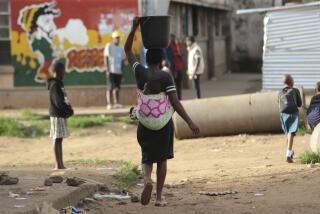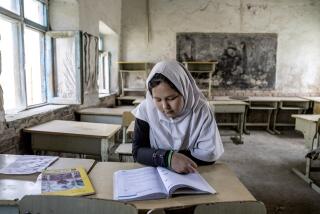UNICEF Urges Focus on Girls’ Education
- Share via
UNITED NATIONS — A UNICEF report released Thursday warns that global development efforts have hit a glass ceiling, and that educating girls is the best way to break through it.
Women make most of the decisions that affect a family’s health and welfare, and thus a nation’s living standard, the report says. Without accelerated action to get more girls into school over the next two years, global goals to reduce poverty and improve the human condition will not be reached, it states.
“International development efforts have been glaringly inadequate at getting girls into school in too many countries,” UNICEF Executive Director Carol Bellamy said in releasing “The State of the World’s Children,” the agency’s report. “We stand no chance of substantially reducing poverty, child mortality, HIV/AIDS and other diseases if we do not ensure that all girls and boys can exercise their right to a basic education.”
The report argues that gender discrimination has undermined development policies and that more attention must be focused on people, especially women, and how they can contribute to a nation’s economic growth, rather than concentrating on economic policies. Investing in education -- with an emphasis on the teaching of girls -- is the best use of a nation’s resources, bringing multiple returns, the report says.
School-age girls in many nations have less access to education because of cultural mores and expectations that boys will become the main wage earners of their families. However, the report notes, educated women can make a greater economic contribution, are more involved in political decisions affecting women, know how to keep themselves and their families healthier and are more likely to educate their own children.
Since the 1995 U.N. Women’s Conference in Beijing, where the value of girls’ education was given wider recognition, there have been significant gains. But the report notes that illiteracy rates are still far higher among women than men, and 65 million school-age girls -- at least 9 million more than boys -- miss out on education each year.
Calling girls’ education “a solution for almost every problem,” the report says that getting girls in school and keeping them there would jump-start progress on the entire development agenda for 2015. The U.N.’s Millennium Development Goals aim to halve the number of people living in poverty and significantly improve health by that target date.
A section of the UNICEF report titled “What Must Change” presents a plan to help nations recognize the value of educating both girls and boys. It calls for better international funding for education, elimination of school fees that keep families from enrolling their children, and integrating education into national plans for poverty reduction.
The report highlights that none of the world’s wealthier countries developed without making a significant investment in education. Only eight developing countries allocate more than a fifth of government spending to education: Ivory Coast, Togo, Malaysia, Azerbaijan, Mexico, Saint Lucia, Comoros and Peru.
Developed countries and global institutions have, for the most part, failed to live up to their pledges of help for education in developing countries. The greatest need is in sub-Saharan Africa, where the number of girls left out of school each year has risen from 20 million in 1990 to 24 million in 2002, according to the report.
More to Read
Sign up for Essential California
The most important California stories and recommendations in your inbox every morning.
You may occasionally receive promotional content from the Los Angeles Times.













